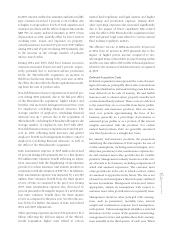American Express 2004 Annual Report Download - page 58
Download and view the complete annual report
Please find page 58 of the 2004 American Express annual report below. You can navigate through the pages in the report by either clicking on the pages listed below, or by using the keyword search tool below to find specific information within the annual report.
with the goal of ensuring there is sufficient cash on hand
to fund business operations over a twelve-month period
regardless of whether the liquidity crisis was caused by
an external, industry or Company specific event. The
contingent funding plan also addresses operating
flexibilities in quickly making these funding sources
available to meet all financial obligations. The simulated
liquidity crisis is defined as a sudden and unexpected
event that temporarily impairs access to or makes
unavailable funding in the unsecured debt markets. The
contingent funding plan includes access to diverse
sources of alternative funding, including but not limited
to its liquidity investment portfolio, committed bank
lines, intercompany borrowings, sale of consumer loans
and cardmember receivables through its existing secu-
ritization programs and sale of other eligible receiv-
ables, such as corporate and small business receivables
and international cardmember loans and receivables,
through enhanced securitization programs. TRS esti-
mates that, under a worst case liquidity crisis scenario,
it has in excess of $30 billion in alternate funding
sources available to cover cash needs over the first 60
days after a liquidity crisis has occurred.
Contingent Securitization Capacity
A key source in the Company’s contingent funding plan
is asset securitization. Management expects that $17
billion of additional consumer loans, small business
loans and cardmember receivables could be sold to
existing securitization trusts. The Company has added
the capabilities to sell a wider variety of cardmember
receivable portfolios to further enhance the Company’s
flexibility in accessing diverse funding sources on a
contingency basis.
The Company believes that the securitized financing
would be available even through adverse conditions
due to the structure, size and relative stability of the
securitization market. Proceeds from secured financings
completed during a liquidity crisis could be used to
meet current obligations, to reduce or retire other con-
tingent funding sources such as bank credit lines, or a
combination of the two. However, other factors affect
the Company’s ability to securitize loans and receiv-
ables, such as credit quality of the assets and the legal,
accounting, regulatory and tax environment for securi-
tization transactions. Material changes in any of these
factors may potentially limit the Company’s ability to
securitize its loans and receivables and could introduce
certain risks to the Company’s ability to meet its finan-
cial obligations. In such a case, the use of investment
securities, asset dispositions, asset monetization strate-
gies and flexibility to reduce operating cash needs could
be utilized to meet its liquidity needs.
Risk Management
For TRS’ charge card and fixed rate lending products,
interest rate exposure is managed through a combina-
tion of shifting the mix of funding toward fixed rate debt
and through the use of derivative instruments, with an
emphasis on interest rate swaps, that effectively fix TRS’
interest expense for the length of the swap. The Com-
pany endeavors to lengthen the maturity of interest rate
hedges in periods of falling interest rates and to shorten
their maturity in periods of rising interest rates. For the
majority of its cardmember loans, which are linked to a
floating rate base and generally reprice each month, TRS
uses floating rate funding. TRS regularly reviews its
strategy and may modify it. Non-trading interest rate
products, primarily interest rate swaps, with notional
amounts of approximately $37.8 billion, a portion of
which extends to 2009, were outstanding at
December 31, 2004.
The detrimental effect on TRS’ pretax earnings of a
hypothetical 100 basis point increase in interest rates
would be approximately $61 million ($50 million
related to the U.S. dollar) and $64 million ($50 million
related to the U.S. dollar), based on the 2004 and 2003
year-end positions, respectively. This effect is primarily
a function of the extent of variable rate funding of
charge card and fixed rate lending products, to the
degree that interest rate exposure is not managed by
derivative financial instruments.
TRS’ foreign exchange risk arising from cross-currency
charges and balance sheet exposures is managed
primarily by entering into agreements to buy and
sell currencies on a spot or forward basis. At
December 31, 2004, foreign currency products with
total notional amounts of approximately $7.5 billion
were outstanding.
Based on the year-end 2004 and 2003 foreign exchange
positions, but excluding forward contracts managing
the anticipated overseas operating results for the
subsequent year, the effect on TRS’ earnings of a
hypothetical 10 percent change in the value of the
U.S. dollar would be immaterial. With respect to forward
contracts related to anticipated overseas operating
results for the subsequent year, a 10 percent change
would hypothetically impact pretax income by
$68 million and $57 million related to the 2004 and
2003 year-end positions, respectively.
AXP
AR.04
56
Financial Review
























